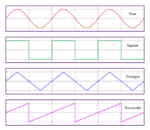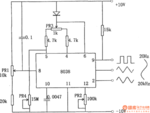Eight
Member level 2
Hello,
I am relatively new to the idea of digital signal synthesis, and I need some help designing a certain circuit. In particular I'm asking for advice on which component to use for my project. The goal is to create a programmable circuit that will be able to output custom waveforms in the low frequency range from 1kHz to 10kHz (this is the frequency range of interest).
I've already managed to design a sine wave generator using a Wien bridge oscillator, but as it turned out, I'll also be needing other waveforms to generate a custom exciation signal. So I thought it would probably be best to use a programmable signal generator and synthesize the desired signal digitally. Someone on IRC suggested I use a chip called a DDS (direct digital synth).
I did some searching and found a number of them from Analog. Most of them are in the MHz range (can I use these for kHz range too?), and some are apparently limited to basic waveforms like sine, square, triangular and maybe saw. While these are the basic waveforms I'll be needing, I'd also like to have an option for custom/arbitrary waveforms like the middle one on the second image.
Which DDS IC do you recommend for this job? Preferably one with an I2C or a SPI serial interface (for interfacing with a microcontroller), and with dual supply voltage (I'm using +/- 9VDC). It only has to be strong enough to drive an external amplifier. Should I actually use a DDS IC here or would it be better to simply use a DAC and drive it with a microcontroller? I hear the audio DAC's normally operate in the frequency range of 20Hz to 20kHz.
Any ideas?
Thanks in advance!
Basic waveforms:

Middle one is a custom waveform:

I am relatively new to the idea of digital signal synthesis, and I need some help designing a certain circuit. In particular I'm asking for advice on which component to use for my project. The goal is to create a programmable circuit that will be able to output custom waveforms in the low frequency range from 1kHz to 10kHz (this is the frequency range of interest).
I've already managed to design a sine wave generator using a Wien bridge oscillator, but as it turned out, I'll also be needing other waveforms to generate a custom exciation signal. So I thought it would probably be best to use a programmable signal generator and synthesize the desired signal digitally. Someone on IRC suggested I use a chip called a DDS (direct digital synth).
I did some searching and found a number of them from Analog. Most of them are in the MHz range (can I use these for kHz range too?), and some are apparently limited to basic waveforms like sine, square, triangular and maybe saw. While these are the basic waveforms I'll be needing, I'd also like to have an option for custom/arbitrary waveforms like the middle one on the second image.
Which DDS IC do you recommend for this job? Preferably one with an I2C or a SPI serial interface (for interfacing with a microcontroller), and with dual supply voltage (I'm using +/- 9VDC). It only has to be strong enough to drive an external amplifier. Should I actually use a DDS IC here or would it be better to simply use a DAC and drive it with a microcontroller? I hear the audio DAC's normally operate in the frequency range of 20Hz to 20kHz.
Any ideas?
Thanks in advance!
Basic waveforms:

Middle one is a custom waveform:
